
This article mainly introduces you to the relevant information about the basic virtual function classes of inheritance and polymorphism in C++. The article introduces it in great detail through example code. It has certain reference learning value for everyone's study or work. It needs Friends, please follow the editor to learn together.
Preface
This article mainly introduces the relevant content about the basic virtual function classes of inheritance and polymorphism in C++, and shares it for everyone. Please refer to it for reference and study. I won’t say much more below. Let’s take a look at the detailed introduction.
Virtual function class
In inheritance, we often mention virtual inheritance. Now let’s explore this kind of virtual function, virtual If the virtual keyword is added in front of a member function of a function class, the member function is called a virtual function. Don't underestimate this virtual function. It can solve many thorny problems in inheritance, and it is even more important for polymorphism. Without it There is no polymorphism, so this knowledge point is very important, and the virtual function table introduced later is extremely important. You must understand it carefully~ Now starting to conceptualize virtual functions, another concept is introduced, that is, rewriting (overwriting), when in a child When a class defines a virtual function that is exactly the same as the parent class, it is said that the function of the subclass overrides (also called overwriting) the virtual function of the parent class. Let me first mention the virtual function table. As will be discussed later, rewriting is to change all the overridden function addresses of the parent class in the virtual function table in the subclass to the addresses of the subclass functions.
Pure virtual function
Write =0 after the formal parameter of the member function, then the member function is a pure virtual function. A class that contains pure virtual functions is called an abstract class (also called an interface class)
Abstract classes cannot instantiate objects. Only after a pure virtual function is redefined in a derived class can the derived class instantiate an object.
Look at an example:
class Person
{
virtual void Display () = 0; // 纯虚函数
protected :
string _name ; // 姓名
};
class Student : public Person
{}; Let’s summarize the concept first:
1. Derived classes override base The virtual function of a class implements polymorphism, requiring the function name, parameter list, and return value to be exactly the same. (Except for covariance)
2. A virtual function is defined in the base class, and the function always maintains the characteristics of a virtual function in the derived class.
3. Only member functions of a class can be defined as virtual functions.
4. Static member functions cannot be defined as virtual functions.
5. If you define a virtual function outside the class, you can only add virtual when declaring the function. You cannot add virtual when defining the function outside the class.
6. Do not call virtual functions in the constructor and destructor. In the constructor and destructor, the object is incomplete and undefined behavior may occur.
7. It is best to declare the destructor of the base class as a virtual function. (Why? In addition, the destructor is special because the name of the destructor of the derived class is different from that of the base class, but it constitutes an override. This is because the compiler has done special processing)
8. The constructor cannot be a virtual function. Although operator= can be defined as a virtual function, it is best not to define operator= as a virtual function because it is easy to cause confusion when used.
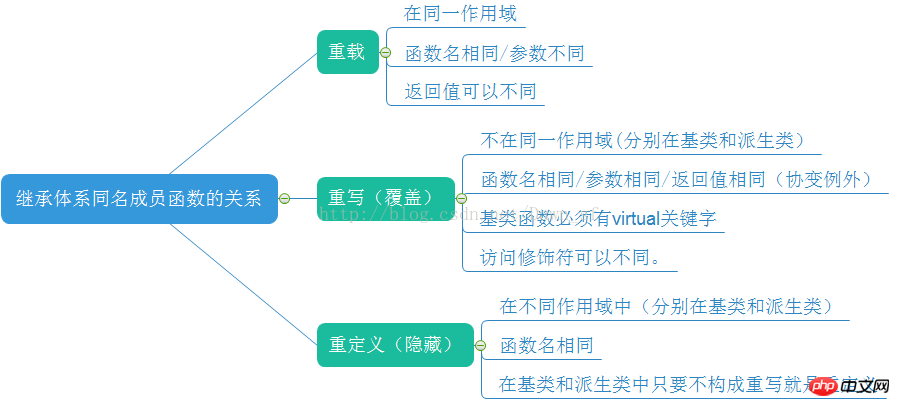
You may ask why is this the above concept? The answers to these contents can be found in the following knowledge~ Okay, then our protagonist todayVirtual function Appearance!!!!
What is a virtual function table? We can find out by writing a program and adjusting a monitoring window.
The following is a class with virtual functions:
#include<iostream>
#include<windows.h>
using namespacestd;
class Base
{
public:
virtual void func1()
{}
virtual void func2()
{}
private:
inta;
};
void Test1()
{
Base b1;
}
int main()
{
Test1();
system("pause");
return0;
}We now click on the monitoring window of b1
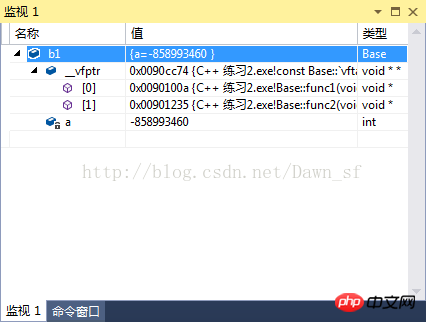
There is a _vfptr here, and what this _vfptr points to is our protagonist, the virtual function table. Everyone will know in a moment that whether it is single inheritance or multiple inheritance, even our diamond-shaped inheritance virtual function table will have different shapes. The virtual function table is a very interesting thing.
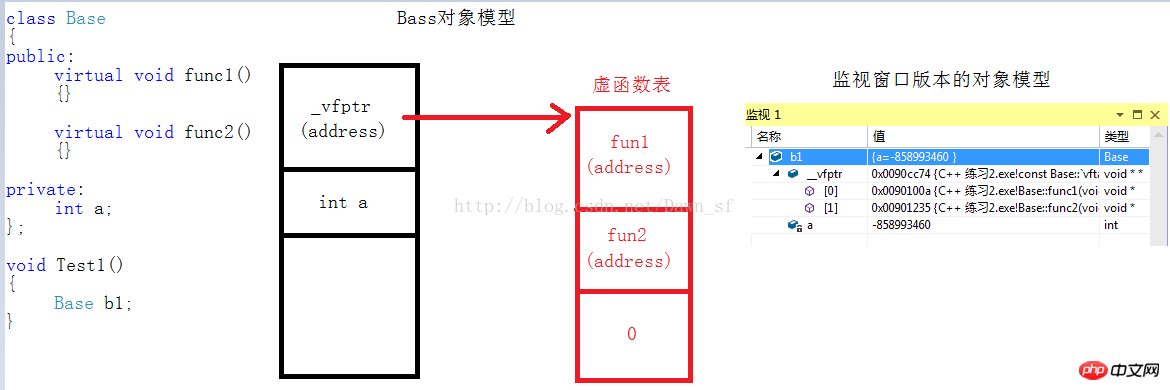
Let’s study the memory layout of single inheritance
Look carefully at the following code:
#include<iostream>
#include<windows.h>
using namespace std;
class Base
{
public:
virtual void func1()
{
cout<< "Base::func1"<< endl;
}
virtual void func2()
{
cout<< "Base::func2"<< endl;
}
private:
inta;
};
class Derive:public Base
{
public:
virtual void func1()
{
cout<< "Derive::func1"<< endl;
}
virtual void func3()
{
cout<< "Derive::func3"<< endl;
}
virtual void func4()
{
cout<< "Derive::func4"<< endl;
}
private:
int b;
};For the Derive class, what do we think will be in its virtual table?
First of all, the subclass's fun1() overrides the parent class's fun1(), and the virtual table stores the subclass's fun1(), then fun2() of the parent class, fun3(), fun4() of the subclass are all virtual functions, so There will be 4 elements in the virtual table, which are fun1() of the subclass, fun2() of the parent class, fun3() of the subclass, and subclass fun4() . Then we bring up the monitoring window to see if what we think is correct?
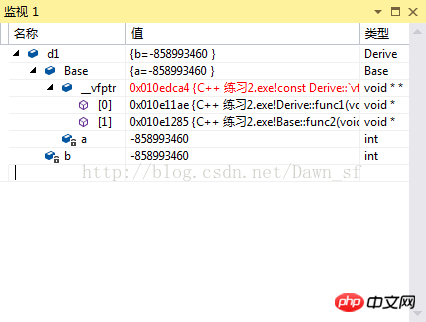
我预计应该是看到fun1() ,fun2() ,fun3() ,fun4()的虚函数表,但是呢这里监视窗口只有两个fun1() , fun2() ,难道我们错了????
这里并不是这样的,只有自己靠得住,我觉得这里的编译器有问题,那我们就得自己探索一下了。 但是在探索之前我们必须来实现一个可以打印虚函数表的函数。
typedef void(*FUNC)(void);
void PrintVTable(int* VTable)
{
cout<< " 虚表地址"<<VTable<< endl;
for(inti = 0;VTable[i] != 0; ++i)
{
printf(" 第%d个虚函数地址 :0X%x,->", i,VTable[i]);
FUNC f = (FUNC)VTable[i];
f();
}
cout<< endl;
}
int main()
{
Derive d1;
PrintVTable((int*)(*(int*)(&d1)));
system("pause");
return0;
}下图来说一下他的缘由:

我们来使用这个函数,该函数代码如下:
//单继承
class Base
{
public:
virtual void func1()
{
cout << "Base::func1" << endl;
}
virtual void func2()
{
cout << "Base::func2" << endl;
}
private:
int a;
};
class Derive :public Base
{
public:
virtual void func1()
{
cout << "Derive::func1" << endl;
}
virtual void func3()
{
cout << "Derive::func3" << endl;
}
virtual void func4()
{
cout << "Derive::func4" << endl;
}
private:
int b;
};
typedef void(*FUNC)(void);
void PrintVTable(int* VTable)
{
cout<< " 虚表地址"<<VTable<< endl;
for(inti = 0;VTable[i] != 0; ++i)
{
printf(" 第%d个虚函数地址 :0X%x,->", i,VTable[i]);
FUNC f = (FUNC)VTable[i];
f();
}
cout<< endl;
}
int main()
{
Derive d1;
PrintVTable((int*)(*(int*)(&d1))); //重点
system("pause");
return0;
}这里我就要讲讲这个传参了,注意这里的传参不好理解,应当细细的"品味".
PrintVTable((int*)(*(int*)(&d1)));
首先我们肯定要拿到d1的首地址,把它强转成int*,让他读取到前4个字节的内容(也就是指向虚表的地址),再然后对那个地址解引用,我们已经拿到虚表的首地址的内容(虚表里面存储的第一个函数的地址)了,但是此时这个变量的类型解引用后是int,不能够传入函数,所以我们再对他进行一个int*的强制类型转换,这样我们就传入参数了,开始函数执行了,我们一切都是在可控的情况下使用强转,使用强转你必须要特别清楚的知道内存的分布结构。
最后我们来看看输出结果:

 到底打印的对不对呢? 我们验证一下:
到底打印的对不对呢? 我们验证一下: 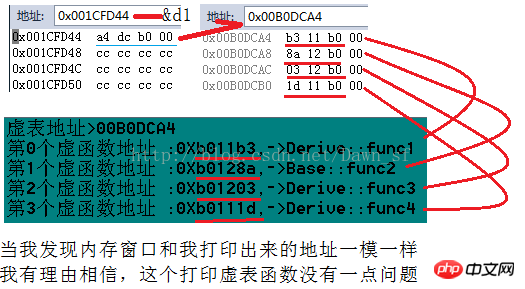
这里我们通过&d1的首地址找到虚表的地址,然后访问地址查看虚表的内容,验证我们自己写的这个函数是正确的。(这里VS还有一个bug,当你第一次打印虚表时程序可能会崩溃,不要担心你重新生成解决方案,再运行一次就可以了。因为当你第一次打印是你虚表最后一个地方可能没有放0,所以你就有可能停不下来然后崩溃。)我们可以看到d1的虚表并不是监视器里面打印的那个样子的,所以有时候VS也会有bug,不要太相信别人,还是自己靠得住。哈哈哈,臭美一下~
我们来研究一下多继承的内存格局
探究完了单继承,我们来看看多继承,我们还是通过代码调试的方法来探究对象模型
看如下代码:
class Base1
{
public:
virtual void func1()
{
cout << "Base1::func1" << endl;
}
virtual void func2()
{
cout << "Base1::func2" << endl;
}
private:
int b1;
};
class Base2
{
public:
virtual void func1()
{
cout << "Base2::func1" << endl;
}
virtual void func2()
{
cout << "Base2::func2" << endl;
}
private:
int b2;
};
class Derive : public Base1, public Base2
{
public:
virtual void func1()
{
cout << "Derive::func1" << endl;
}
virtual void func3()
{
cout << "Derive::func3" << endl;
}
private:
int d1;
};
typedef void(*FUNC) ();
void PrintVTable(int* VTable)
{
cout << " 虚表地址>" << VTable << endl;
for (int i = 0; VTable[i] != 0; ++i)
{
printf(" 第%d个虚函数地址 :0X%x,->", i, VTable[i]);
FUNC f = (FUNC)VTable[i];
f();
}
cout << endl;
}
void Test1()
{
Derive d1;
//Base2虚函数表在对象Base1后面
int* VTable = (int*)(*(int*)&d1);
PrintVTable(VTable);
int* VTable2 = (int *)(*((int*)&d1 + sizeof (Base1) / 4));
PrintVTable(VTable2);
}
int main()
{
Test1();
system("pause");
return 0;
}现在我们现在知道会有两个虚函数表,分别是Base1和Base2的虚函数表,但是呢!我们的子类里的fun3()函数怎么办?它是放在Base1里还是Base2里还是自己开辟一个虚函数表呢?我们先调一下监视窗口:
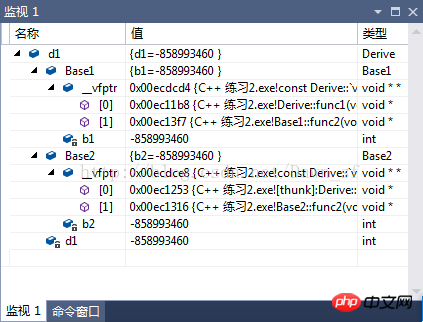
监视窗口又不靠谱了。。。。完全没有找到fun3().那我们直接看打印出来的虚函数表。
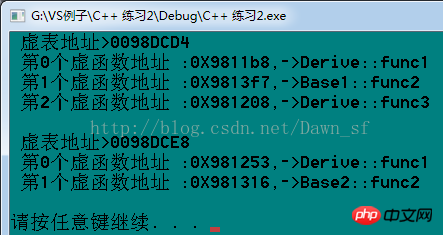
现在很清楚了,fun3()在Base1的虚函数表中,而Base1是先继承的类,好了现在我们记住这个结论,当涉及多继承时,子类的虚函数会存在先继承的那个类的虚函数表里。记住了!
我们现在来看多继承的对象模型:
现在我们来结束一下上面我列的那么多概念现在我来逐一的解释为什么要这样.
1.为什么静态成员函数不能定义为虚函数?
因为静态成员函数它是一个大家共享的一个资源,但是这个静态成员函数没有this指针,而且虚函数变只有对象才能能调到,但是静态成员函数不需要对象就可以调用,所以这里是有冲突的.
2.为什么不要在构造函数和析构函数里面调用虚函数?
构造函数当中不适合用虚函数的原因是:在构造对象的过程中,还没有为“虚函数表”分配内存。所以,这个调用也是违背先实例化后调用的准则析构函数当中不适用虚函数的原因是:一般析构函数先析构子类的,当你在父类中调用一个重写的fun()函数,虚函数表里面就是子类的fun()函数,这时候已经子类已经析构了,当你调用的时候就会调用不到.
现在我在写最后一个知识点,为什么尽量最好把基类的析构函数声明为虚函数??
现在我们再来写一个例子,我们都知道平时正常的实例化对象然后再释放是没有一点问题的,但是现在我这里举一个特例:
我们都知道父类的指针可以指向子类,现在呢我们我们用一个父类的指针new一个子类的对象。
//多态 析构函数
class Base
{
public:
virtual void func1()
{
cout << "Base::func1" << endl;
}
virtual void func2()
{
cout << "Base::func2" << endl;
}
virtual ~Base()
{
cout << "~Base" << endl;
}
private:
int a;
};
class Derive :public Base
{
public:
virtual void func1()
{
cout << "Derive::func1" << endl;
}
virtual ~Derive()
{
cout << "~Derive"<< endl;
}
private:
int b;
};
void Test1()
{
Base* q = new Derive;
delete q;
}
int main()
{
Test1();
system("pause");
return 0;
}这里面可能会有下一篇要说的多态,所以可能理解起来会费劲一点。
注意这里我先让父类的析构函数不为虚函数(去掉virtual),我们看看输出结果:
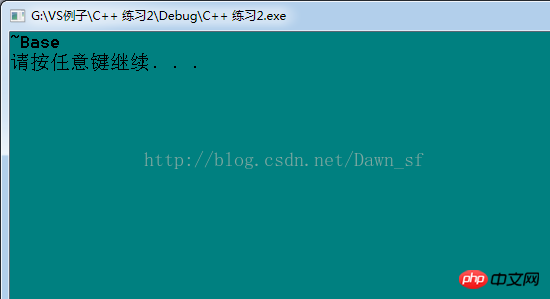
这里它没有调用子类的析构函数,因为他是一个父类类型指针,所以它只能调用父类的析构函数,无权访问子类的析构函数,这种调用方法会导致内存泄漏,所以这里就是有缺陷的,但是C++是不会允许自己有缺陷,他就会想办法解决这个问题,这里就运用到了我们下次要讲的多态。现在我们让加上为父类析构函数加上virtual,让它变回虚函数,我们再运行一次程序的:
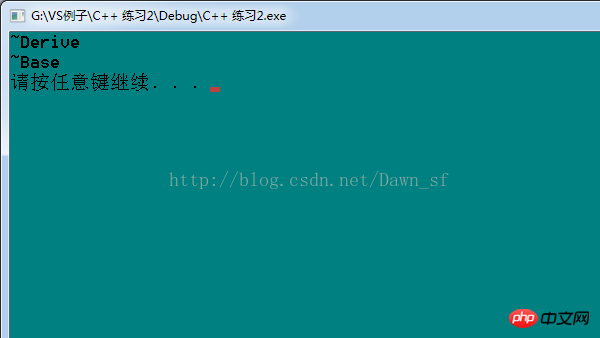
诶! 子类的虚函数又被调用了,这里发生了什么呢?? 来我们老方法打开监视窗口。

刚刚这种情况就是多态,多态性可以简单地概括为“一个接口,多种方法”,程序在运行时才决定调用的函数,它是面向对象编程领域的核心概念。这个我们下一个博客专门会总结多态.
当然虚函数的知识点远远没有这么一点,这里可能只是冰山一角,比如说菱形继承的虚函数表是什么样?然后菱形虚拟继承又是什么样子呢? 这些等我总结一下会专门写一个博客来讨论菱形继承。虚函数表我们应该已经知道是什么东西了,也知道单继承和多继承中它的应用,这些应该就足够了,这些其实都是都是为你让你更好的理解继承和多态,当然你一定到分清楚重写,重定义,重载的他们分别的含义是什么. 这一块可能有点绕,但是我们必须要掌握.
The above is the detailed content of Introducing the basic virtual function classes related to inheritance and polymorphism in C++. For more information, please follow other related articles on the PHP Chinese website!




